Project on Globalisation Impact on Marketing Functions at John Lewis
VerifiedAdded on 2020/10/23
|32
|7565
|225
Project
AI Summary
This project examines the positive impact of globalisation on the marketing functions within the retail industry, using John Lewis as a case study. It begins with an introduction that defines globalisation and its effects on various business functions, including marketing. The project outlines the aims, objectives, and research questions, as well as the rationale for selecting this topic. It includes a detailed project management plan, covering scope, cost, time, risk, communication, resources, and quality. A work breakdown structure and Gantt chart are provided to illustrate the project timeline. The research methodology section describes the research methods (qualitative and quantitative), research design (descriptive), and research approach. Data collection and analysis methods are also discussed, followed by a section on ethical considerations. The project analyzes and interprets the collected data, offers recommendations, and concludes with a reflection on the research process.

MANAGING A
SUCCESSFUL BUSINESS
PROJECT
SUCCESSFUL BUSINESS
PROJECT
Paraphrase This Document
Need a fresh take? Get an instant paraphrase of this document with our AI Paraphraser
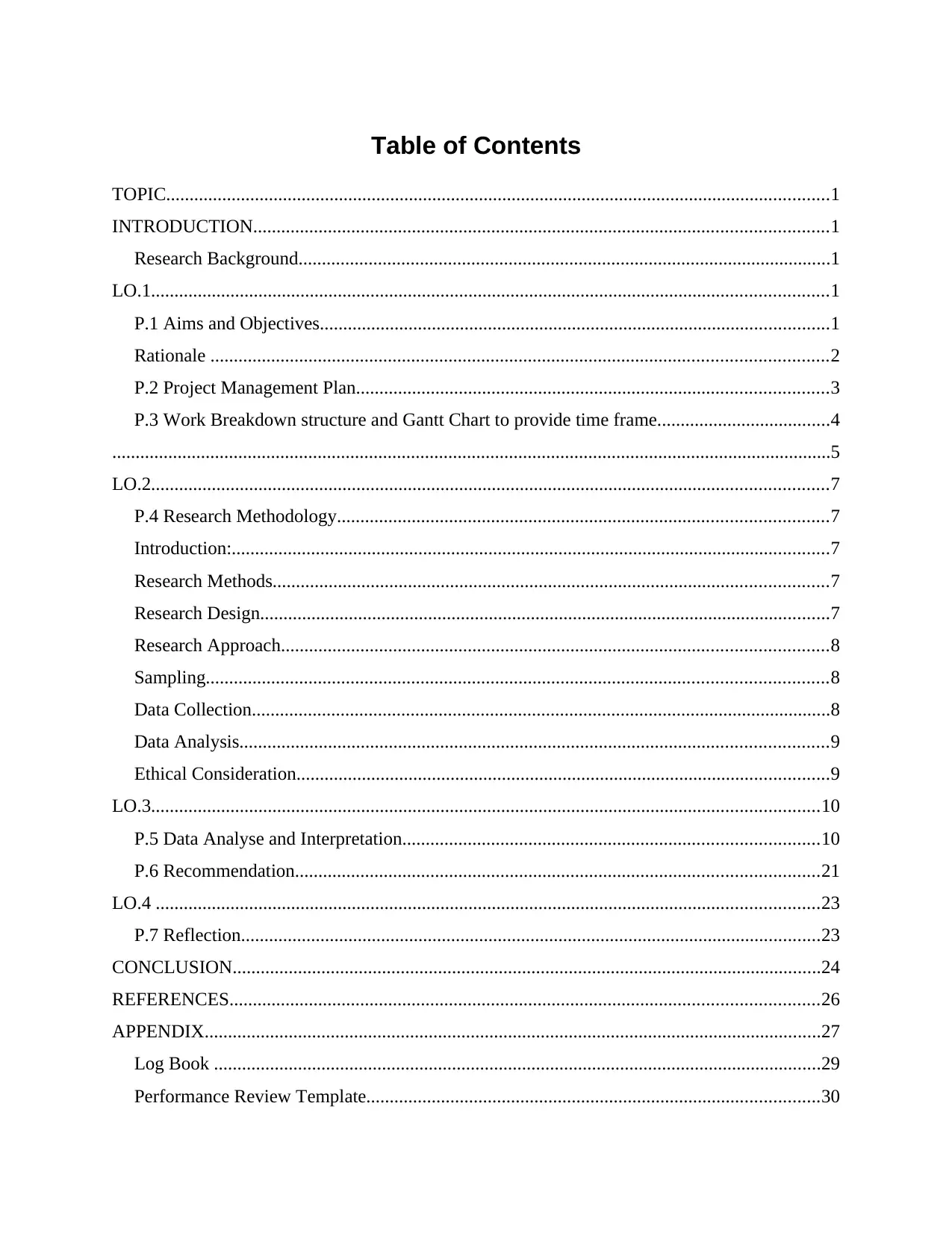
Table of Contents
TOPIC..............................................................................................................................................1
INTRODUCTION...........................................................................................................................1
Research Background..................................................................................................................1
LO.1.................................................................................................................................................1
P.1 Aims and Objectives.............................................................................................................1
Rationale ....................................................................................................................................2
P.2 Project Management Plan.....................................................................................................3
P.3 Work Breakdown structure and Gantt Chart to provide time frame.....................................4
..........................................................................................................................................................5
LO.2.................................................................................................................................................7
P.4 Research Methodology.........................................................................................................7
Introduction:................................................................................................................................7
Research Methods.......................................................................................................................7
Research Design..........................................................................................................................7
Research Approach.....................................................................................................................8
Sampling.....................................................................................................................................8
Data Collection............................................................................................................................8
Data Analysis..............................................................................................................................9
Ethical Consideration..................................................................................................................9
LO.3...............................................................................................................................................10
P.5 Data Analyse and Interpretation.........................................................................................10
P.6 Recommendation................................................................................................................21
LO.4 ..............................................................................................................................................23
P.7 Reflection............................................................................................................................23
CONCLUSION..............................................................................................................................24
REFERENCES..............................................................................................................................26
APPENDIX....................................................................................................................................27
Log Book ..................................................................................................................................29
Performance Review Template.................................................................................................30
TOPIC..............................................................................................................................................1
INTRODUCTION...........................................................................................................................1
Research Background..................................................................................................................1
LO.1.................................................................................................................................................1
P.1 Aims and Objectives.............................................................................................................1
Rationale ....................................................................................................................................2
P.2 Project Management Plan.....................................................................................................3
P.3 Work Breakdown structure and Gantt Chart to provide time frame.....................................4
..........................................................................................................................................................5
LO.2.................................................................................................................................................7
P.4 Research Methodology.........................................................................................................7
Introduction:................................................................................................................................7
Research Methods.......................................................................................................................7
Research Design..........................................................................................................................7
Research Approach.....................................................................................................................8
Sampling.....................................................................................................................................8
Data Collection............................................................................................................................8
Data Analysis..............................................................................................................................9
Ethical Consideration..................................................................................................................9
LO.3...............................................................................................................................................10
P.5 Data Analyse and Interpretation.........................................................................................10
P.6 Recommendation................................................................................................................21
LO.4 ..............................................................................................................................................23
P.7 Reflection............................................................................................................................23
CONCLUSION..............................................................................................................................24
REFERENCES..............................................................................................................................26
APPENDIX....................................................................................................................................27
Log Book ..................................................................................................................................29
Performance Review Template.................................................................................................30
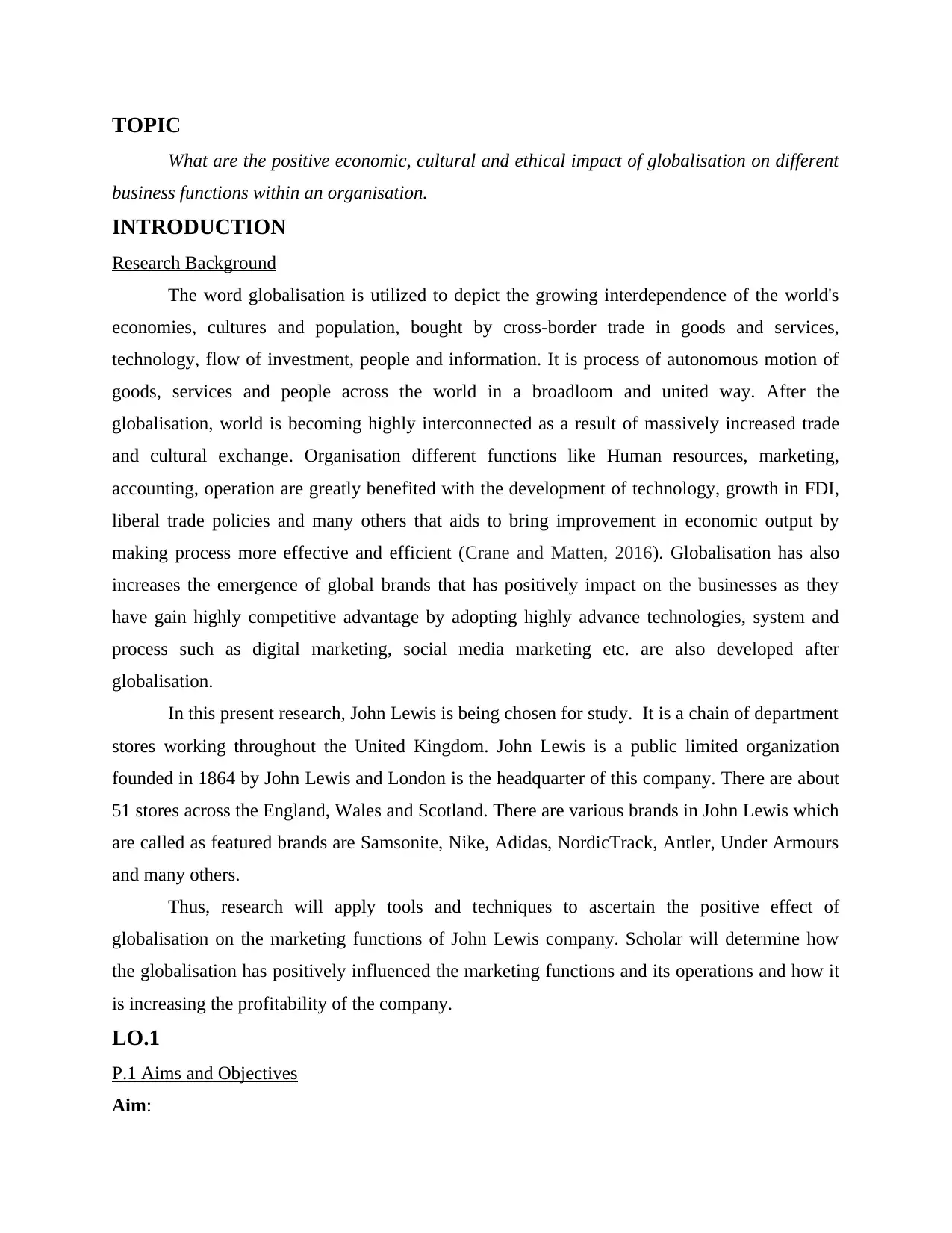
TOPIC
What are the positive economic, cultural and ethical impact of globalisation on different
business functions within an organisation.
INTRODUCTION
Research Background
The word globalisation is utilized to depict the growing interdependence of the world's
economies, cultures and population, bought by cross-border trade in goods and services,
technology, flow of investment, people and information. It is process of autonomous motion of
goods, services and people across the world in a broadloom and united way. After the
globalisation, world is becoming highly interconnected as a result of massively increased trade
and cultural exchange. Organisation different functions like Human resources, marketing,
accounting, operation are greatly benefited with the development of technology, growth in FDI,
liberal trade policies and many others that aids to bring improvement in economic output by
making process more effective and efficient (Crane and Matten, 2016). Globalisation has also
increases the emergence of global brands that has positively impact on the businesses as they
have gain highly competitive advantage by adopting highly advance technologies, system and
process such as digital marketing, social media marketing etc. are also developed after
globalisation.
In this present research, John Lewis is being chosen for study. It is a chain of department
stores working throughout the United Kingdom. John Lewis is a public limited organization
founded in 1864 by John Lewis and London is the headquarter of this company. There are about
51 stores across the England, Wales and Scotland. There are various brands in John Lewis which
are called as featured brands are Samsonite, Nike, Adidas, NordicTrack, Antler, Under Armours
and many others.
Thus, research will apply tools and techniques to ascertain the positive effect of
globalisation on the marketing functions of John Lewis company. Scholar will determine how
the globalisation has positively influenced the marketing functions and its operations and how it
is increasing the profitability of the company.
LO.1
P.1 Aims and Objectives
Aim:
What are the positive economic, cultural and ethical impact of globalisation on different
business functions within an organisation.
INTRODUCTION
Research Background
The word globalisation is utilized to depict the growing interdependence of the world's
economies, cultures and population, bought by cross-border trade in goods and services,
technology, flow of investment, people and information. It is process of autonomous motion of
goods, services and people across the world in a broadloom and united way. After the
globalisation, world is becoming highly interconnected as a result of massively increased trade
and cultural exchange. Organisation different functions like Human resources, marketing,
accounting, operation are greatly benefited with the development of technology, growth in FDI,
liberal trade policies and many others that aids to bring improvement in economic output by
making process more effective and efficient (Crane and Matten, 2016). Globalisation has also
increases the emergence of global brands that has positively impact on the businesses as they
have gain highly competitive advantage by adopting highly advance technologies, system and
process such as digital marketing, social media marketing etc. are also developed after
globalisation.
In this present research, John Lewis is being chosen for study. It is a chain of department
stores working throughout the United Kingdom. John Lewis is a public limited organization
founded in 1864 by John Lewis and London is the headquarter of this company. There are about
51 stores across the England, Wales and Scotland. There are various brands in John Lewis which
are called as featured brands are Samsonite, Nike, Adidas, NordicTrack, Antler, Under Armours
and many others.
Thus, research will apply tools and techniques to ascertain the positive effect of
globalisation on the marketing functions of John Lewis company. Scholar will determine how
the globalisation has positively influenced the marketing functions and its operations and how it
is increasing the profitability of the company.
LO.1
P.1 Aims and Objectives
Aim:
⊘ This is a preview!⊘
Do you want full access?
Subscribe today to unlock all pages.

Trusted by 1+ million students worldwide
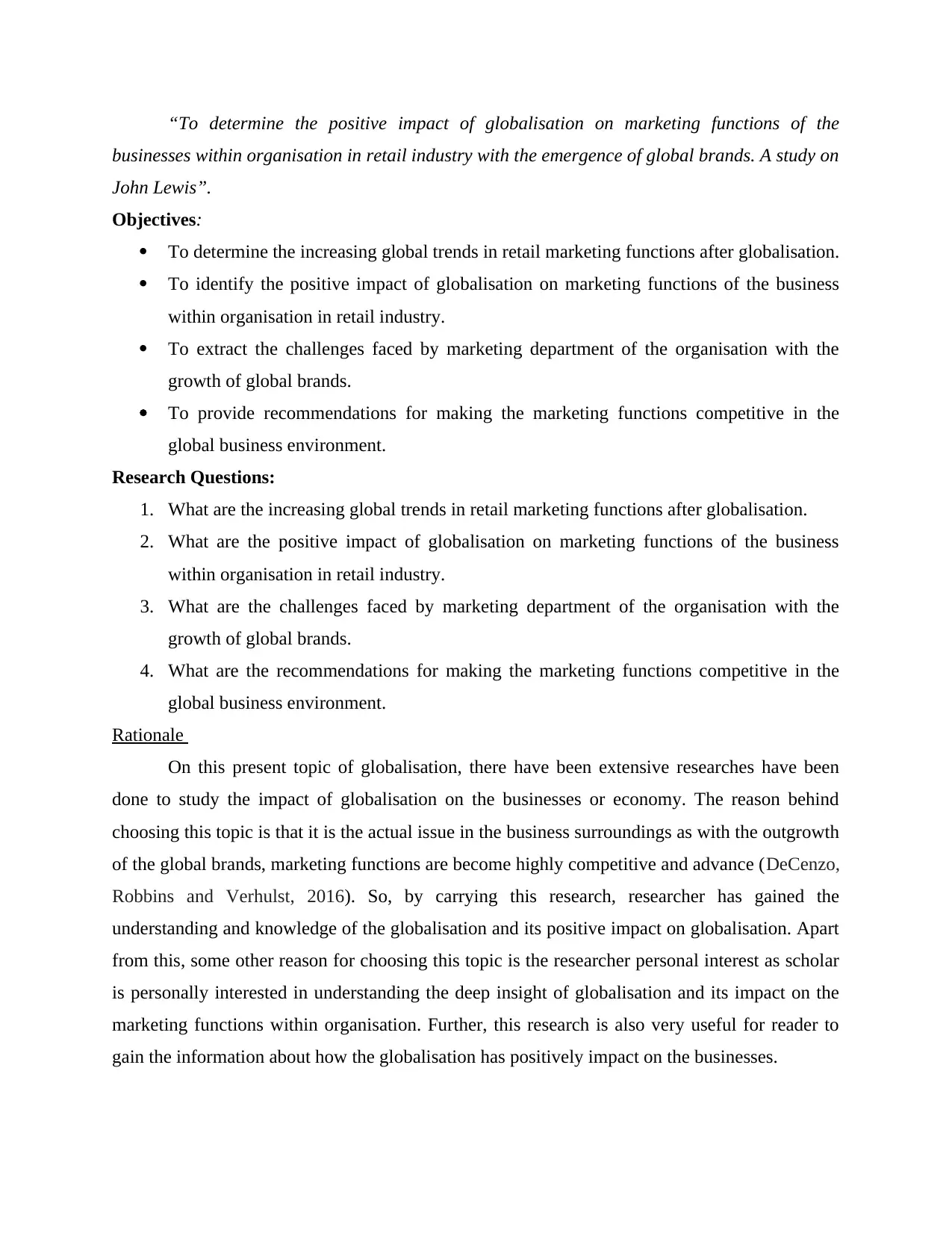
“To determine the positive impact of globalisation on marketing functions of the
businesses within organisation in retail industry with the emergence of global brands. A study on
John Lewis”.
Objectives:
To determine the increasing global trends in retail marketing functions after globalisation.
To identify the positive impact of globalisation on marketing functions of the business
within organisation in retail industry.
To extract the challenges faced by marketing department of the organisation with the
growth of global brands.
To provide recommendations for making the marketing functions competitive in the
global business environment.
Research Questions:
1. What are the increasing global trends in retail marketing functions after globalisation.
2. What are the positive impact of globalisation on marketing functions of the business
within organisation in retail industry.
3. What are the challenges faced by marketing department of the organisation with the
growth of global brands.
4. What are the recommendations for making the marketing functions competitive in the
global business environment.
Rationale
On this present topic of globalisation, there have been extensive researches have been
done to study the impact of globalisation on the businesses or economy. The reason behind
choosing this topic is that it is the actual issue in the business surroundings as with the outgrowth
of the global brands, marketing functions are become highly competitive and advance (DeCenzo,
Robbins and Verhulst, 2016). So, by carrying this research, researcher has gained the
understanding and knowledge of the globalisation and its positive impact on globalisation. Apart
from this, some other reason for choosing this topic is the researcher personal interest as scholar
is personally interested in understanding the deep insight of globalisation and its impact on the
marketing functions within organisation. Further, this research is also very useful for reader to
gain the information about how the globalisation has positively impact on the businesses.
businesses within organisation in retail industry with the emergence of global brands. A study on
John Lewis”.
Objectives:
To determine the increasing global trends in retail marketing functions after globalisation.
To identify the positive impact of globalisation on marketing functions of the business
within organisation in retail industry.
To extract the challenges faced by marketing department of the organisation with the
growth of global brands.
To provide recommendations for making the marketing functions competitive in the
global business environment.
Research Questions:
1. What are the increasing global trends in retail marketing functions after globalisation.
2. What are the positive impact of globalisation on marketing functions of the business
within organisation in retail industry.
3. What are the challenges faced by marketing department of the organisation with the
growth of global brands.
4. What are the recommendations for making the marketing functions competitive in the
global business environment.
Rationale
On this present topic of globalisation, there have been extensive researches have been
done to study the impact of globalisation on the businesses or economy. The reason behind
choosing this topic is that it is the actual issue in the business surroundings as with the outgrowth
of the global brands, marketing functions are become highly competitive and advance (DeCenzo,
Robbins and Verhulst, 2016). So, by carrying this research, researcher has gained the
understanding and knowledge of the globalisation and its positive impact on globalisation. Apart
from this, some other reason for choosing this topic is the researcher personal interest as scholar
is personally interested in understanding the deep insight of globalisation and its impact on the
marketing functions within organisation. Further, this research is also very useful for reader to
gain the information about how the globalisation has positively impact on the businesses.
Paraphrase This Document
Need a fresh take? Get an instant paraphrase of this document with our AI Paraphraser
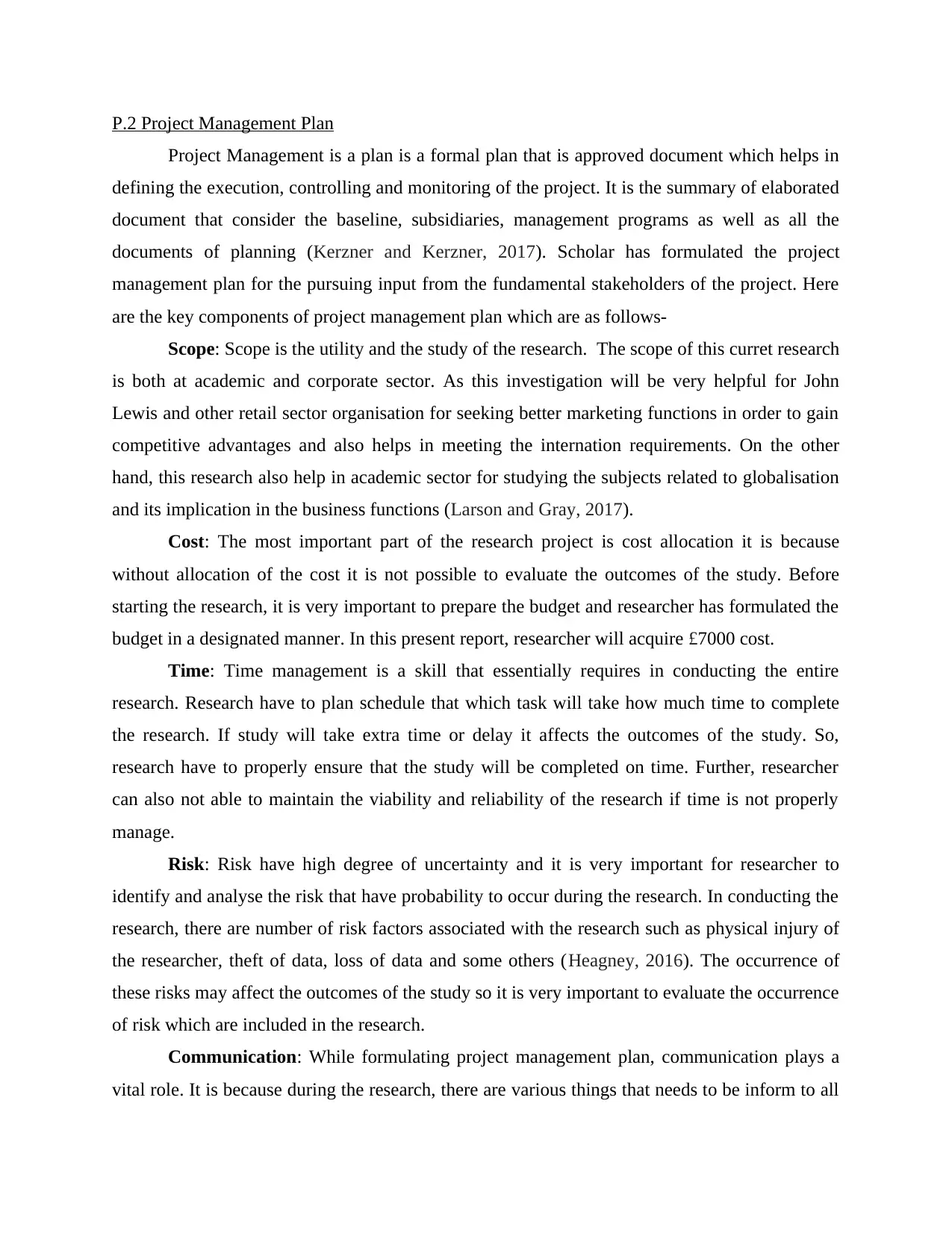
P.2 Project Management Plan
Project Management is a plan is a formal plan that is approved document which helps in
defining the execution, controlling and monitoring of the project. It is the summary of elaborated
document that consider the baseline, subsidiaries, management programs as well as all the
documents of planning (Kerzner and Kerzner, 2017). Scholar has formulated the project
management plan for the pursuing input from the fundamental stakeholders of the project. Here
are the key components of project management plan which are as follows-
Scope: Scope is the utility and the study of the research. The scope of this curret research
is both at academic and corporate sector. As this investigation will be very helpful for John
Lewis and other retail sector organisation for seeking better marketing functions in order to gain
competitive advantages and also helps in meeting the internation requirements. On the other
hand, this research also help in academic sector for studying the subjects related to globalisation
and its implication in the business functions (Larson and Gray, 2017).
Cost: The most important part of the research project is cost allocation it is because
without allocation of the cost it is not possible to evaluate the outcomes of the study. Before
starting the research, it is very important to prepare the budget and researcher has formulated the
budget in a designated manner. In this present report, researcher will acquire £7000 cost.
Time: Time management is a skill that essentially requires in conducting the entire
research. Research have to plan schedule that which task will take how much time to complete
the research. If study will take extra time or delay it affects the outcomes of the study. So,
research have to properly ensure that the study will be completed on time. Further, researcher
can also not able to maintain the viability and reliability of the research if time is not properly
manage.
Risk: Risk have high degree of uncertainty and it is very important for researcher to
identify and analyse the risk that have probability to occur during the research. In conducting the
research, there are number of risk factors associated with the research such as physical injury of
the researcher, theft of data, loss of data and some others (Heagney, 2016). The occurrence of
these risks may affect the outcomes of the study so it is very important to evaluate the occurrence
of risk which are included in the research.
Communication: While formulating project management plan, communication plays a
vital role. It is because during the research, there are various things that needs to be inform to all
Project Management is a plan is a formal plan that is approved document which helps in
defining the execution, controlling and monitoring of the project. It is the summary of elaborated
document that consider the baseline, subsidiaries, management programs as well as all the
documents of planning (Kerzner and Kerzner, 2017). Scholar has formulated the project
management plan for the pursuing input from the fundamental stakeholders of the project. Here
are the key components of project management plan which are as follows-
Scope: Scope is the utility and the study of the research. The scope of this curret research
is both at academic and corporate sector. As this investigation will be very helpful for John
Lewis and other retail sector organisation for seeking better marketing functions in order to gain
competitive advantages and also helps in meeting the internation requirements. On the other
hand, this research also help in academic sector for studying the subjects related to globalisation
and its implication in the business functions (Larson and Gray, 2017).
Cost: The most important part of the research project is cost allocation it is because
without allocation of the cost it is not possible to evaluate the outcomes of the study. Before
starting the research, it is very important to prepare the budget and researcher has formulated the
budget in a designated manner. In this present report, researcher will acquire £7000 cost.
Time: Time management is a skill that essentially requires in conducting the entire
research. Research have to plan schedule that which task will take how much time to complete
the research. If study will take extra time or delay it affects the outcomes of the study. So,
research have to properly ensure that the study will be completed on time. Further, researcher
can also not able to maintain the viability and reliability of the research if time is not properly
manage.
Risk: Risk have high degree of uncertainty and it is very important for researcher to
identify and analyse the risk that have probability to occur during the research. In conducting the
research, there are number of risk factors associated with the research such as physical injury of
the researcher, theft of data, loss of data and some others (Heagney, 2016). The occurrence of
these risks may affect the outcomes of the study so it is very important to evaluate the occurrence
of risk which are included in the research.
Communication: While formulating project management plan, communication plays a
vital role. It is because during the research, there are various things that needs to be inform to all
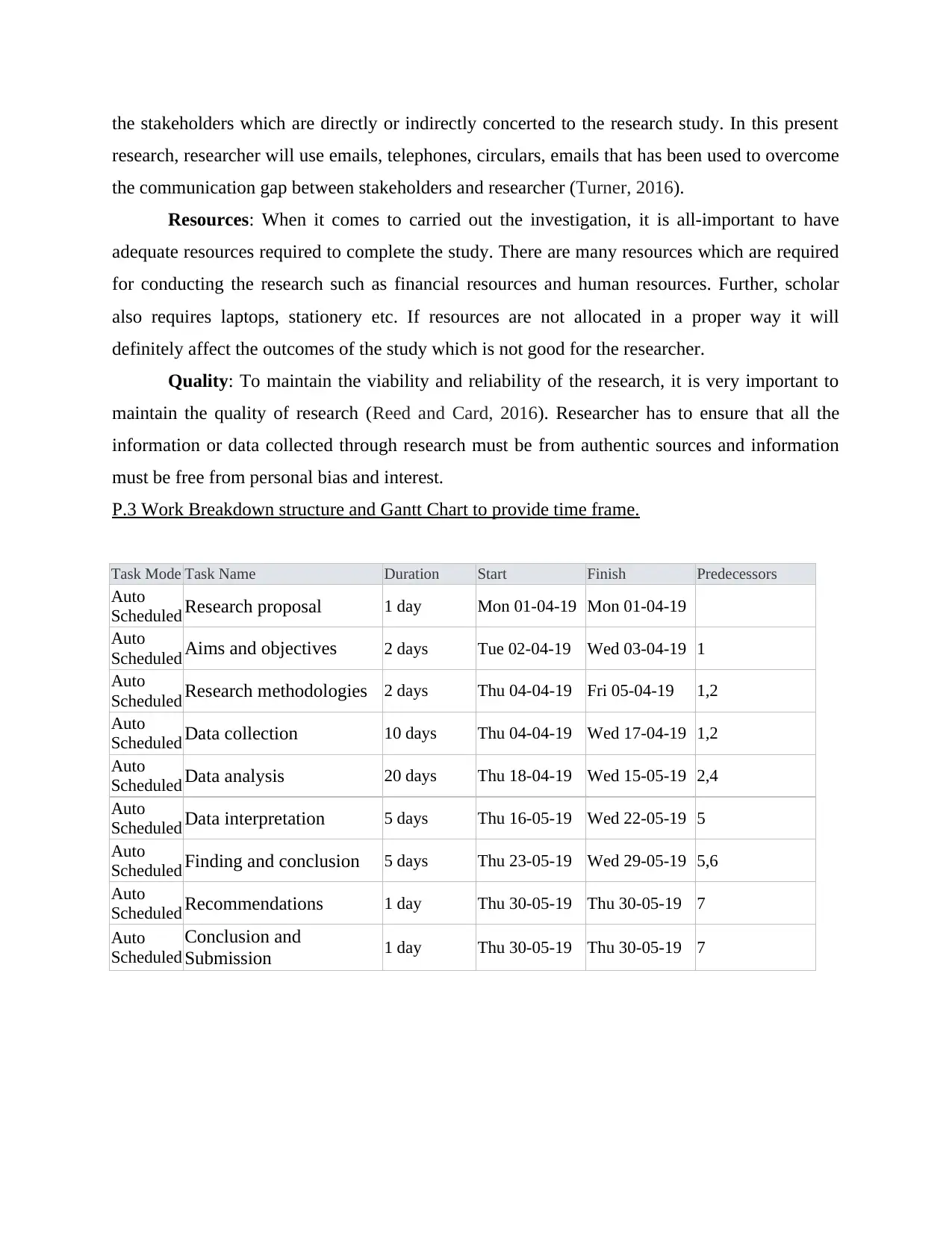
the stakeholders which are directly or indirectly concerted to the research study. In this present
research, researcher will use emails, telephones, circulars, emails that has been used to overcome
the communication gap between stakeholders and researcher (Turner, 2016).
Resources: When it comes to carried out the investigation, it is all-important to have
adequate resources required to complete the study. There are many resources which are required
for conducting the research such as financial resources and human resources. Further, scholar
also requires laptops, stationery etc. If resources are not allocated in a proper way it will
definitely affect the outcomes of the study which is not good for the researcher.
Quality: To maintain the viability and reliability of the research, it is very important to
maintain the quality of research (Reed and Card, 2016). Researcher has to ensure that all the
information or data collected through research must be from authentic sources and information
must be free from personal bias and interest.
P.3 Work Breakdown structure and Gantt Chart to provide time frame.
Task Mode Task Name Duration Start Finish Predecessors
Auto
Scheduled Research proposal 1 day Mon 01-04-19 Mon 01-04-19
Auto
Scheduled Aims and objectives 2 days Tue 02-04-19 Wed 03-04-19 1
Auto
Scheduled Research methodologies 2 days Thu 04-04-19 Fri 05-04-19 1,2
Auto
Scheduled Data collection 10 days Thu 04-04-19 Wed 17-04-19 1,2
Auto
Scheduled Data analysis 20 days Thu 18-04-19 Wed 15-05-19 2,4
Auto
Scheduled Data interpretation 5 days Thu 16-05-19 Wed 22-05-19 5
Auto
Scheduled Finding and conclusion 5 days Thu 23-05-19 Wed 29-05-19 5,6
Auto
Scheduled Recommendations 1 day Thu 30-05-19 Thu 30-05-19 7
Auto
Scheduled
Conclusion and
Submission 1 day Thu 30-05-19 Thu 30-05-19 7
research, researcher will use emails, telephones, circulars, emails that has been used to overcome
the communication gap between stakeholders and researcher (Turner, 2016).
Resources: When it comes to carried out the investigation, it is all-important to have
adequate resources required to complete the study. There are many resources which are required
for conducting the research such as financial resources and human resources. Further, scholar
also requires laptops, stationery etc. If resources are not allocated in a proper way it will
definitely affect the outcomes of the study which is not good for the researcher.
Quality: To maintain the viability and reliability of the research, it is very important to
maintain the quality of research (Reed and Card, 2016). Researcher has to ensure that all the
information or data collected through research must be from authentic sources and information
must be free from personal bias and interest.
P.3 Work Breakdown structure and Gantt Chart to provide time frame.
Task Mode Task Name Duration Start Finish Predecessors
Auto
Scheduled Research proposal 1 day Mon 01-04-19 Mon 01-04-19
Auto
Scheduled Aims and objectives 2 days Tue 02-04-19 Wed 03-04-19 1
Auto
Scheduled Research methodologies 2 days Thu 04-04-19 Fri 05-04-19 1,2
Auto
Scheduled Data collection 10 days Thu 04-04-19 Wed 17-04-19 1,2
Auto
Scheduled Data analysis 20 days Thu 18-04-19 Wed 15-05-19 2,4
Auto
Scheduled Data interpretation 5 days Thu 16-05-19 Wed 22-05-19 5
Auto
Scheduled Finding and conclusion 5 days Thu 23-05-19 Wed 29-05-19 5,6
Auto
Scheduled Recommendations 1 day Thu 30-05-19 Thu 30-05-19 7
Auto
Scheduled
Conclusion and
Submission 1 day Thu 30-05-19 Thu 30-05-19 7
⊘ This is a preview!⊘
Do you want full access?
Subscribe today to unlock all pages.

Trusted by 1+ million students worldwide
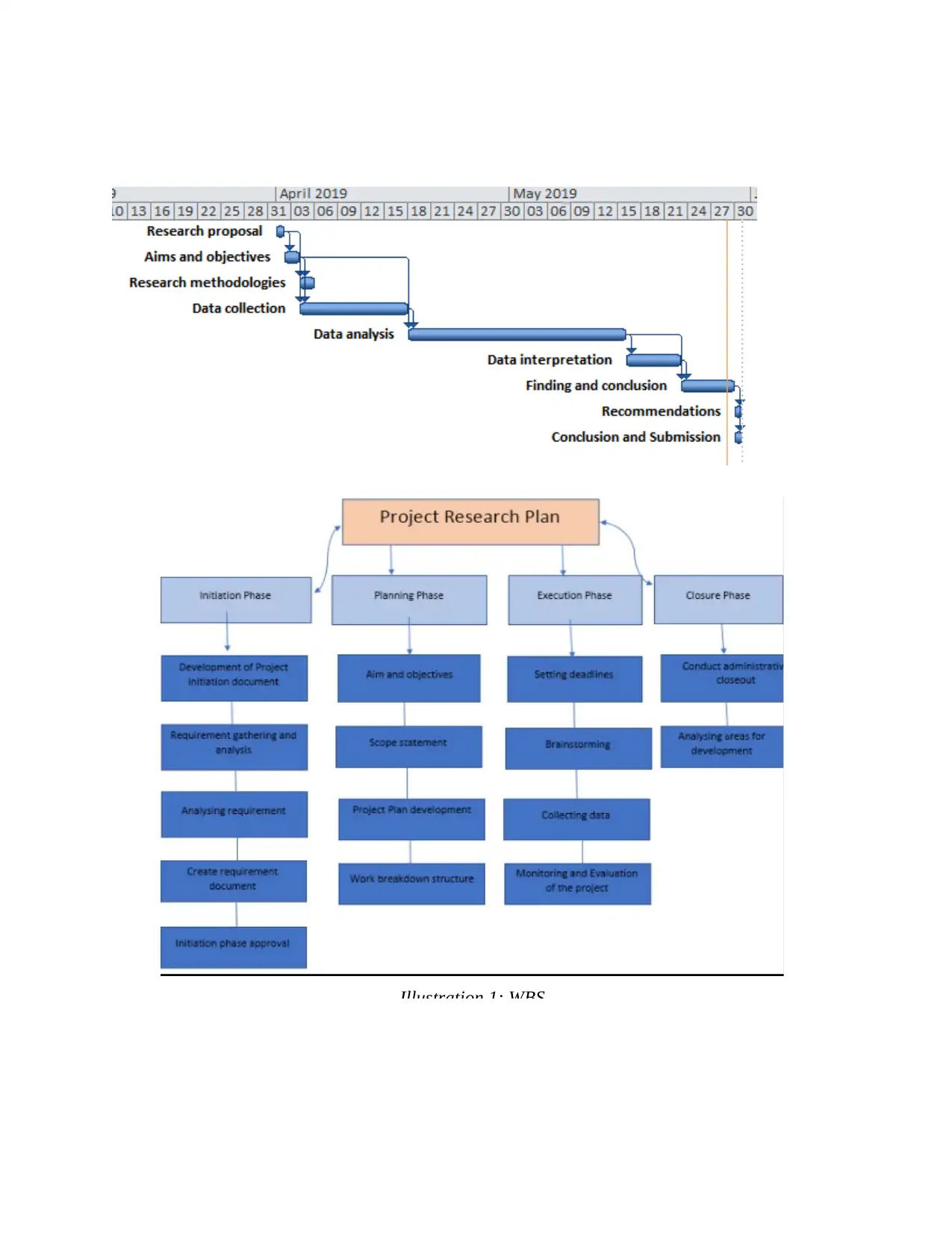
Illustration 1: WBS
Paraphrase This Document
Need a fresh take? Get an instant paraphrase of this document with our AI Paraphraser
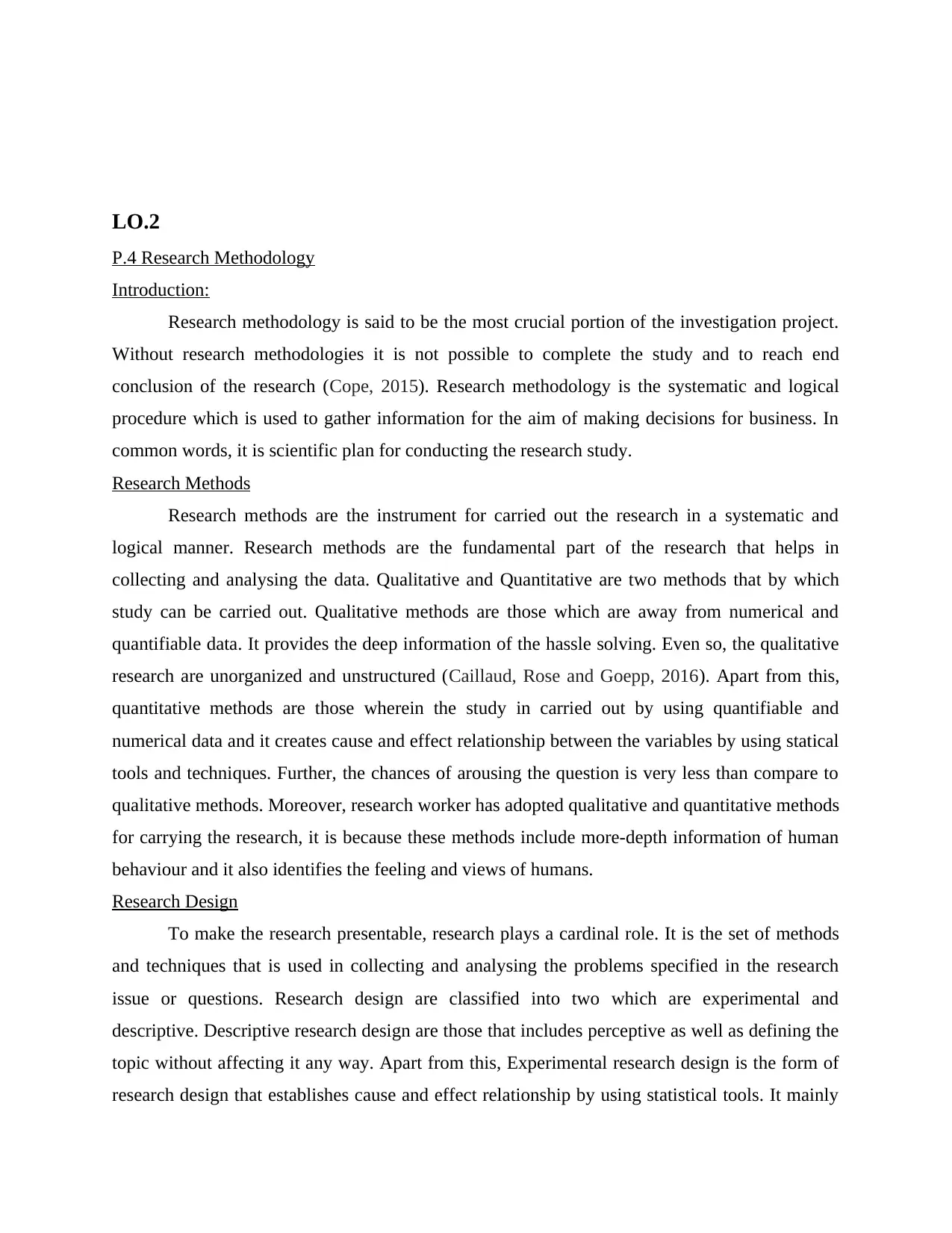
LO.2
P.4 Research Methodology
Introduction:
Research methodology is said to be the most crucial portion of the investigation project.
Without research methodologies it is not possible to complete the study and to reach end
conclusion of the research (Cope, 2015). Research methodology is the systematic and logical
procedure which is used to gather information for the aim of making decisions for business. In
common words, it is scientific plan for conducting the research study.
Research Methods
Research methods are the instrument for carried out the research in a systematic and
logical manner. Research methods are the fundamental part of the research that helps in
collecting and analysing the data. Qualitative and Quantitative are two methods that by which
study can be carried out. Qualitative methods are those which are away from numerical and
quantifiable data. It provides the deep information of the hassle solving. Even so, the qualitative
research are unorganized and unstructured (Caillaud, Rose and Goepp, 2016). Apart from this,
quantitative methods are those wherein the study in carried out by using quantifiable and
numerical data and it creates cause and effect relationship between the variables by using statical
tools and techniques. Further, the chances of arousing the question is very less than compare to
qualitative methods. Moreover, research worker has adopted qualitative and quantitative methods
for carrying the research, it is because these methods include more-depth information of human
behaviour and it also identifies the feeling and views of humans.
Research Design
To make the research presentable, research plays a cardinal role. It is the set of methods
and techniques that is used in collecting and analysing the problems specified in the research
issue or questions. Research design are classified into two which are experimental and
descriptive. Descriptive research design are those that includes perceptive as well as defining the
topic without affecting it any way. Apart from this, Experimental research design is the form of
research design that establishes cause and effect relationship by using statistical tools. It mainly
P.4 Research Methodology
Introduction:
Research methodology is said to be the most crucial portion of the investigation project.
Without research methodologies it is not possible to complete the study and to reach end
conclusion of the research (Cope, 2015). Research methodology is the systematic and logical
procedure which is used to gather information for the aim of making decisions for business. In
common words, it is scientific plan for conducting the research study.
Research Methods
Research methods are the instrument for carried out the research in a systematic and
logical manner. Research methods are the fundamental part of the research that helps in
collecting and analysing the data. Qualitative and Quantitative are two methods that by which
study can be carried out. Qualitative methods are those which are away from numerical and
quantifiable data. It provides the deep information of the hassle solving. Even so, the qualitative
research are unorganized and unstructured (Caillaud, Rose and Goepp, 2016). Apart from this,
quantitative methods are those wherein the study in carried out by using quantifiable and
numerical data and it creates cause and effect relationship between the variables by using statical
tools and techniques. Further, the chances of arousing the question is very less than compare to
qualitative methods. Moreover, research worker has adopted qualitative and quantitative methods
for carrying the research, it is because these methods include more-depth information of human
behaviour and it also identifies the feeling and views of humans.
Research Design
To make the research presentable, research plays a cardinal role. It is the set of methods
and techniques that is used in collecting and analysing the problems specified in the research
issue or questions. Research design are classified into two which are experimental and
descriptive. Descriptive research design are those that includes perceptive as well as defining the
topic without affecting it any way. Apart from this, Experimental research design is the form of
research design that establishes cause and effect relationship by using statistical tools. It mainly
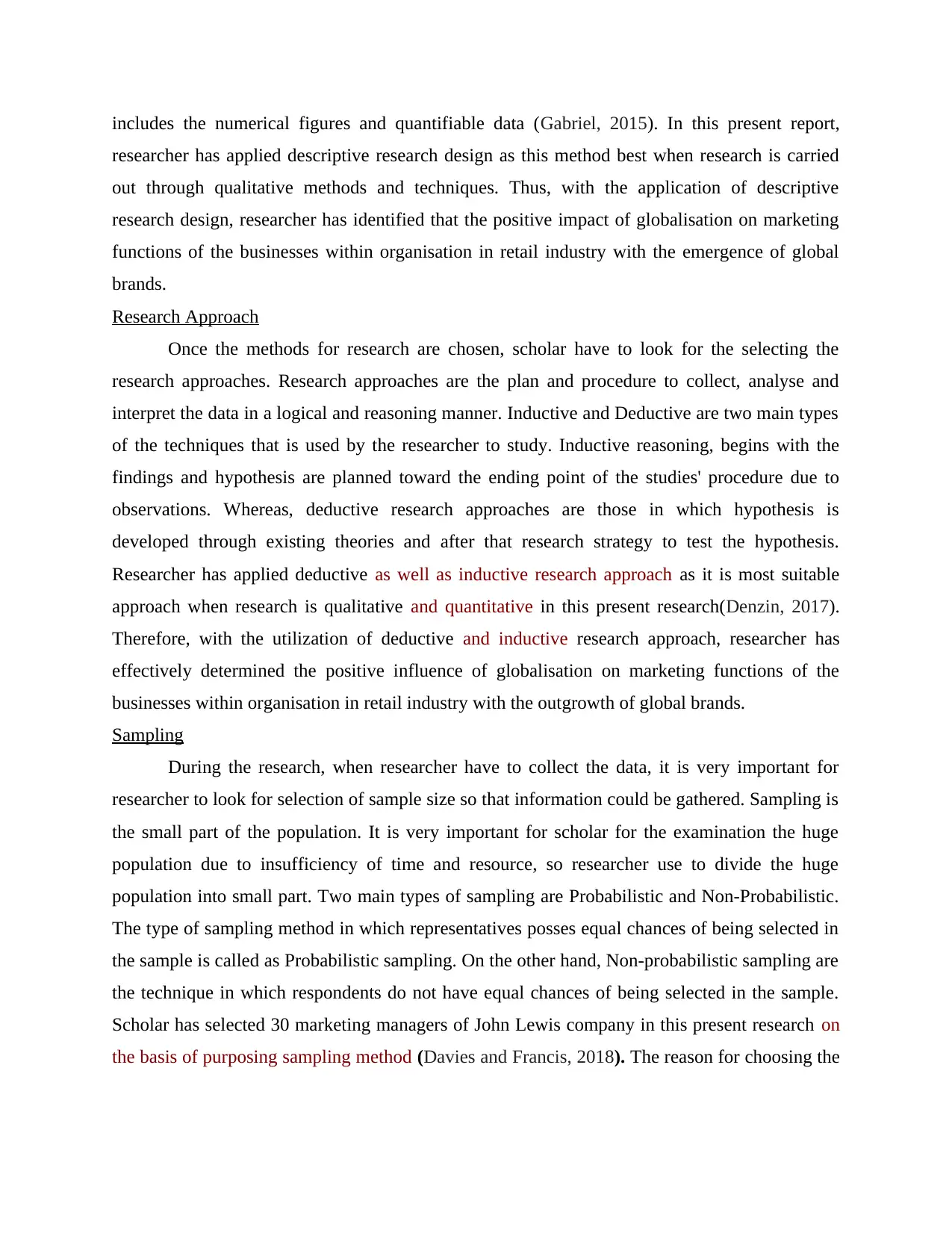
includes the numerical figures and quantifiable data (Gabriel, 2015). In this present report,
researcher has applied descriptive research design as this method best when research is carried
out through qualitative methods and techniques. Thus, with the application of descriptive
research design, researcher has identified that the positive impact of globalisation on marketing
functions of the businesses within organisation in retail industry with the emergence of global
brands.
Research Approach
Once the methods for research are chosen, scholar have to look for the selecting the
research approaches. Research approaches are the plan and procedure to collect, analyse and
interpret the data in a logical and reasoning manner. Inductive and Deductive are two main types
of the techniques that is used by the researcher to study. Inductive reasoning, begins with the
findings and hypothesis are planned toward the ending point of the studies' procedure due to
observations. Whereas, deductive research approaches are those in which hypothesis is
developed through existing theories and after that research strategy to test the hypothesis.
Researcher has applied deductive as well as inductive research approach as it is most suitable
approach when research is qualitative and quantitative in this present research(Denzin, 2017).
Therefore, with the utilization of deductive and inductive research approach, researcher has
effectively determined the positive influence of globalisation on marketing functions of the
businesses within organisation in retail industry with the outgrowth of global brands.
Sampling
During the research, when researcher have to collect the data, it is very important for
researcher to look for selection of sample size so that information could be gathered. Sampling is
the small part of the population. It is very important for scholar for the examination the huge
population due to insufficiency of time and resource, so researcher use to divide the huge
population into small part. Two main types of sampling are Probabilistic and Non-Probabilistic.
The type of sampling method in which representatives posses equal chances of being selected in
the sample is called as Probabilistic sampling. On the other hand, Non-probabilistic sampling are
the technique in which respondents do not have equal chances of being selected in the sample.
Scholar has selected 30 marketing managers of John Lewis company in this present research on
the basis of purposing sampling method (Davies and Francis, 2018). The reason for choosing the
researcher has applied descriptive research design as this method best when research is carried
out through qualitative methods and techniques. Thus, with the application of descriptive
research design, researcher has identified that the positive impact of globalisation on marketing
functions of the businesses within organisation in retail industry with the emergence of global
brands.
Research Approach
Once the methods for research are chosen, scholar have to look for the selecting the
research approaches. Research approaches are the plan and procedure to collect, analyse and
interpret the data in a logical and reasoning manner. Inductive and Deductive are two main types
of the techniques that is used by the researcher to study. Inductive reasoning, begins with the
findings and hypothesis are planned toward the ending point of the studies' procedure due to
observations. Whereas, deductive research approaches are those in which hypothesis is
developed through existing theories and after that research strategy to test the hypothesis.
Researcher has applied deductive as well as inductive research approach as it is most suitable
approach when research is qualitative and quantitative in this present research(Denzin, 2017).
Therefore, with the utilization of deductive and inductive research approach, researcher has
effectively determined the positive influence of globalisation on marketing functions of the
businesses within organisation in retail industry with the outgrowth of global brands.
Sampling
During the research, when researcher have to collect the data, it is very important for
researcher to look for selection of sample size so that information could be gathered. Sampling is
the small part of the population. It is very important for scholar for the examination the huge
population due to insufficiency of time and resource, so researcher use to divide the huge
population into small part. Two main types of sampling are Probabilistic and Non-Probabilistic.
The type of sampling method in which representatives posses equal chances of being selected in
the sample is called as Probabilistic sampling. On the other hand, Non-probabilistic sampling are
the technique in which respondents do not have equal chances of being selected in the sample.
Scholar has selected 30 marketing managers of John Lewis company in this present research on
the basis of purposing sampling method (Davies and Francis, 2018). The reason for choosing the
⊘ This is a preview!⊘
Do you want full access?
Subscribe today to unlock all pages.

Trusted by 1+ million students worldwide
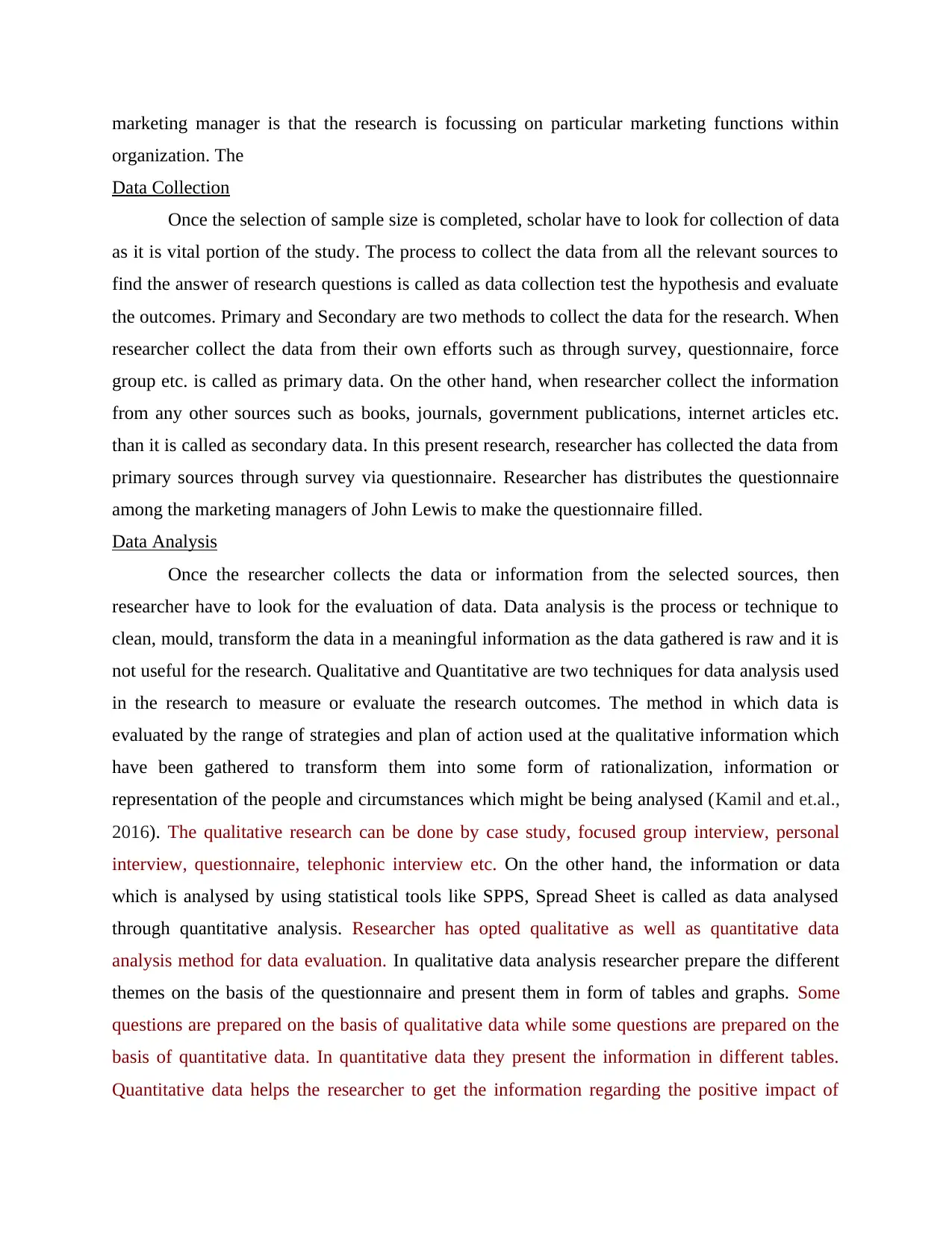
marketing manager is that the research is focussing on particular marketing functions within
organization. The
Data Collection
Once the selection of sample size is completed, scholar have to look for collection of data
as it is vital portion of the study. The process to collect the data from all the relevant sources to
find the answer of research questions is called as data collection test the hypothesis and evaluate
the outcomes. Primary and Secondary are two methods to collect the data for the research. When
researcher collect the data from their own efforts such as through survey, questionnaire, force
group etc. is called as primary data. On the other hand, when researcher collect the information
from any other sources such as books, journals, government publications, internet articles etc.
than it is called as secondary data. In this present research, researcher has collected the data from
primary sources through survey via questionnaire. Researcher has distributes the questionnaire
among the marketing managers of John Lewis to make the questionnaire filled.
Data Analysis
Once the researcher collects the data or information from the selected sources, then
researcher have to look for the evaluation of data. Data analysis is the process or technique to
clean, mould, transform the data in a meaningful information as the data gathered is raw and it is
not useful for the research. Qualitative and Quantitative are two techniques for data analysis used
in the research to measure or evaluate the research outcomes. The method in which data is
evaluated by the range of strategies and plan of action used at the qualitative information which
have been gathered to transform them into some form of rationalization, information or
representation of the people and circumstances which might be being analysed (Kamil and et.al.,
2016). The qualitative research can be done by case study, focused group interview, personal
interview, questionnaire, telephonic interview etc. On the other hand, the information or data
which is analysed by using statistical tools like SPPS, Spread Sheet is called as data analysed
through quantitative analysis. Researcher has opted qualitative as well as quantitative data
analysis method for data evaluation. In qualitative data analysis researcher prepare the different
themes on the basis of the questionnaire and present them in form of tables and graphs. Some
questions are prepared on the basis of qualitative data while some questions are prepared on the
basis of quantitative data. In quantitative data they present the information in different tables.
Quantitative data helps the researcher to get the information regarding the positive impact of
organization. The
Data Collection
Once the selection of sample size is completed, scholar have to look for collection of data
as it is vital portion of the study. The process to collect the data from all the relevant sources to
find the answer of research questions is called as data collection test the hypothesis and evaluate
the outcomes. Primary and Secondary are two methods to collect the data for the research. When
researcher collect the data from their own efforts such as through survey, questionnaire, force
group etc. is called as primary data. On the other hand, when researcher collect the information
from any other sources such as books, journals, government publications, internet articles etc.
than it is called as secondary data. In this present research, researcher has collected the data from
primary sources through survey via questionnaire. Researcher has distributes the questionnaire
among the marketing managers of John Lewis to make the questionnaire filled.
Data Analysis
Once the researcher collects the data or information from the selected sources, then
researcher have to look for the evaluation of data. Data analysis is the process or technique to
clean, mould, transform the data in a meaningful information as the data gathered is raw and it is
not useful for the research. Qualitative and Quantitative are two techniques for data analysis used
in the research to measure or evaluate the research outcomes. The method in which data is
evaluated by the range of strategies and plan of action used at the qualitative information which
have been gathered to transform them into some form of rationalization, information or
representation of the people and circumstances which might be being analysed (Kamil and et.al.,
2016). The qualitative research can be done by case study, focused group interview, personal
interview, questionnaire, telephonic interview etc. On the other hand, the information or data
which is analysed by using statistical tools like SPPS, Spread Sheet is called as data analysed
through quantitative analysis. Researcher has opted qualitative as well as quantitative data
analysis method for data evaluation. In qualitative data analysis researcher prepare the different
themes on the basis of the questionnaire and present them in form of tables and graphs. Some
questions are prepared on the basis of qualitative data while some questions are prepared on the
basis of quantitative data. In quantitative data they present the information in different tables.
Quantitative data helps the researcher to get the information regarding the positive impact of
Paraphrase This Document
Need a fresh take? Get an instant paraphrase of this document with our AI Paraphraser
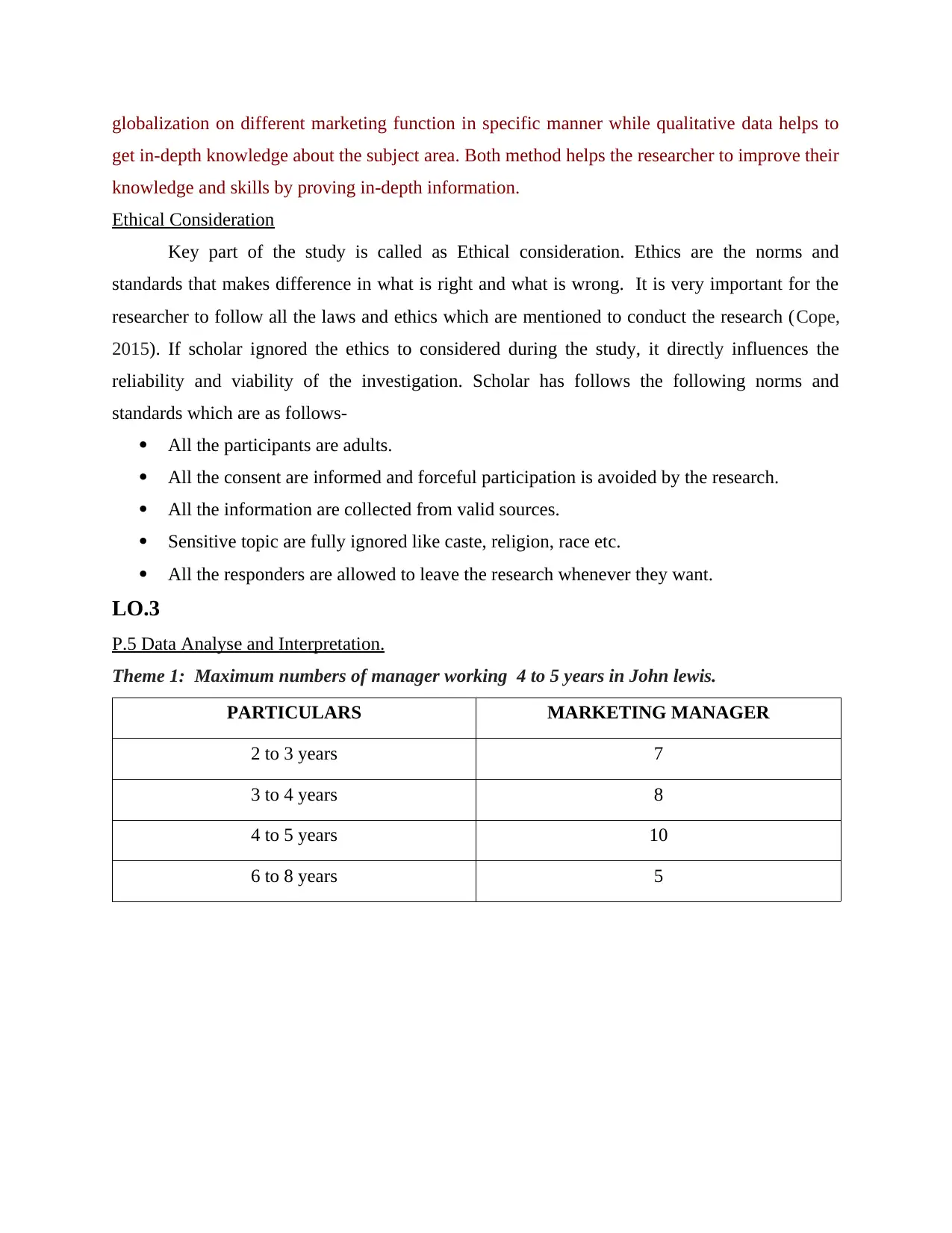
globalization on different marketing function in specific manner while qualitative data helps to
get in-depth knowledge about the subject area. Both method helps the researcher to improve their
knowledge and skills by proving in-depth information.
Ethical Consideration
Key part of the study is called as Ethical consideration. Ethics are the norms and
standards that makes difference in what is right and what is wrong. It is very important for the
researcher to follow all the laws and ethics which are mentioned to conduct the research (Cope,
2015). If scholar ignored the ethics to considered during the study, it directly influences the
reliability and viability of the investigation. Scholar has follows the following norms and
standards which are as follows-
All the participants are adults.
All the consent are informed and forceful participation is avoided by the research.
All the information are collected from valid sources.
Sensitive topic are fully ignored like caste, religion, race etc.
All the responders are allowed to leave the research whenever they want.
LO.3
P.5 Data Analyse and Interpretation.
Theme 1: Maximum numbers of manager working 4 to 5 years in John lewis.
PARTICULARS MARKETING MANAGER
2 to 3 years 7
3 to 4 years 8
4 to 5 years 10
6 to 8 years 5
get in-depth knowledge about the subject area. Both method helps the researcher to improve their
knowledge and skills by proving in-depth information.
Ethical Consideration
Key part of the study is called as Ethical consideration. Ethics are the norms and
standards that makes difference in what is right and what is wrong. It is very important for the
researcher to follow all the laws and ethics which are mentioned to conduct the research (Cope,
2015). If scholar ignored the ethics to considered during the study, it directly influences the
reliability and viability of the investigation. Scholar has follows the following norms and
standards which are as follows-
All the participants are adults.
All the consent are informed and forceful participation is avoided by the research.
All the information are collected from valid sources.
Sensitive topic are fully ignored like caste, religion, race etc.
All the responders are allowed to leave the research whenever they want.
LO.3
P.5 Data Analyse and Interpretation.
Theme 1: Maximum numbers of manager working 4 to 5 years in John lewis.
PARTICULARS MARKETING MANAGER
2 to 3 years 7
3 to 4 years 8
4 to 5 years 10
6 to 8 years 5
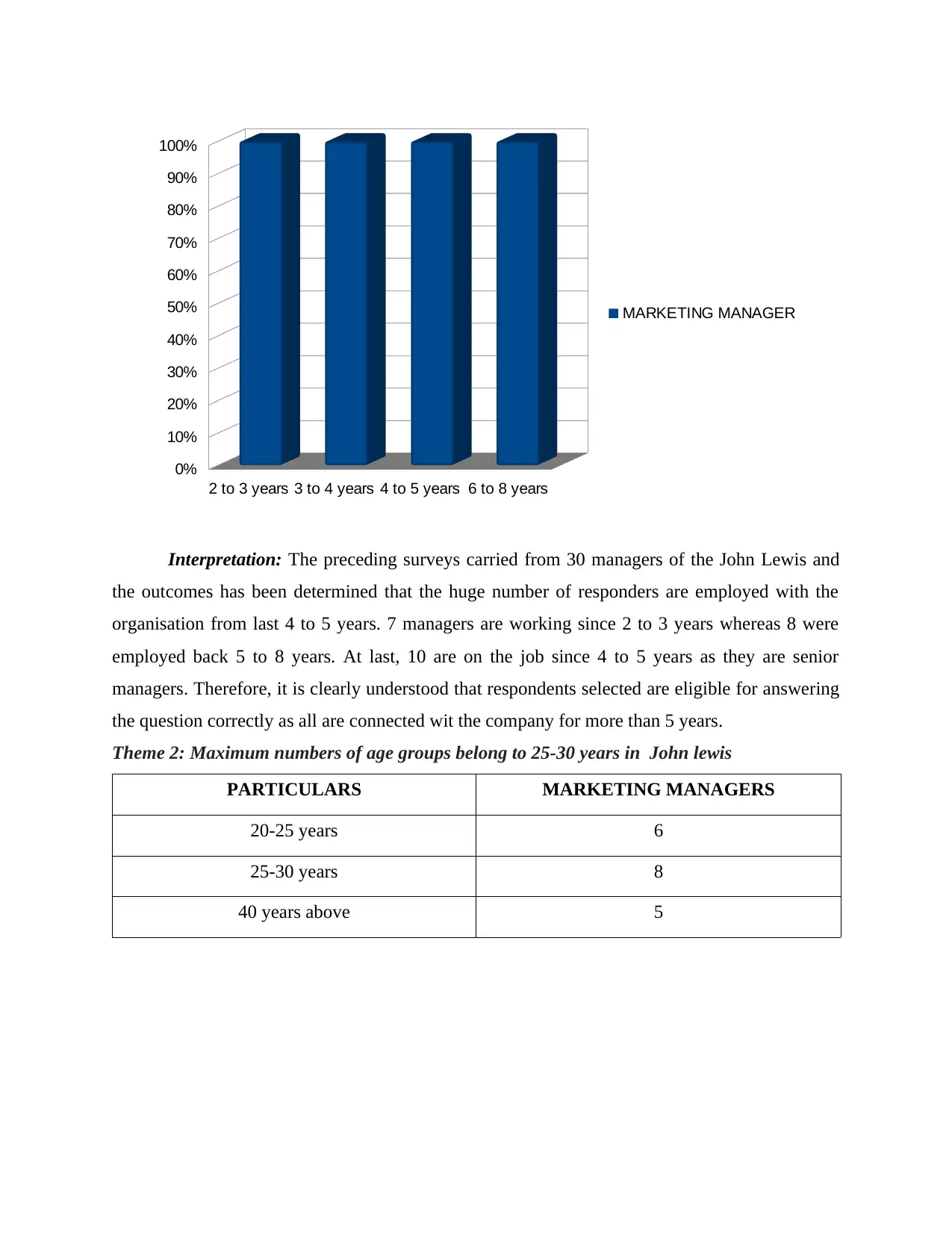
Interpretation: The preceding surveys carried from 30 managers of the John Lewis and
the outcomes has been determined that the huge number of responders are employed with the
organisation from last 4 to 5 years. 7 managers are working since 2 to 3 years whereas 8 were
employed back 5 to 8 years. At last, 10 are on the job since 4 to 5 years as they are senior
managers. Therefore, it is clearly understood that respondents selected are eligible for answering
the question correctly as all are connected wit the company for more than 5 years.
Theme 2: Maximum numbers of age groups belong to 25-30 years in John lewis
PARTICULARS MARKETING MANAGERS
20-25 years 6
25-30 years 8
40 years above 5
2 to 3 years 3 to 4 years 4 to 5 years 6 to 8 years
0%
10%
20%
30%
40%
50%
60%
70%
80%
90%
100%
MARKETING MANAGER
the outcomes has been determined that the huge number of responders are employed with the
organisation from last 4 to 5 years. 7 managers are working since 2 to 3 years whereas 8 were
employed back 5 to 8 years. At last, 10 are on the job since 4 to 5 years as they are senior
managers. Therefore, it is clearly understood that respondents selected are eligible for answering
the question correctly as all are connected wit the company for more than 5 years.
Theme 2: Maximum numbers of age groups belong to 25-30 years in John lewis
PARTICULARS MARKETING MANAGERS
20-25 years 6
25-30 years 8
40 years above 5
2 to 3 years 3 to 4 years 4 to 5 years 6 to 8 years
0%
10%
20%
30%
40%
50%
60%
70%
80%
90%
100%
MARKETING MANAGER
⊘ This is a preview!⊘
Do you want full access?
Subscribe today to unlock all pages.

Trusted by 1+ million students worldwide
1 out of 32
Related Documents
Your All-in-One AI-Powered Toolkit for Academic Success.
+13062052269
info@desklib.com
Available 24*7 on WhatsApp / Email
![[object Object]](/_next/static/media/star-bottom.7253800d.svg)
Unlock your academic potential
Copyright © 2020–2025 A2Z Services. All Rights Reserved. Developed and managed by ZUCOL.





